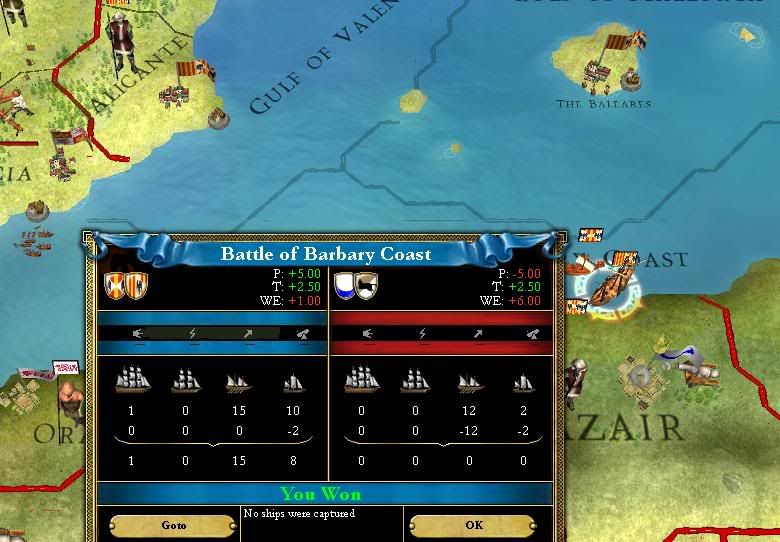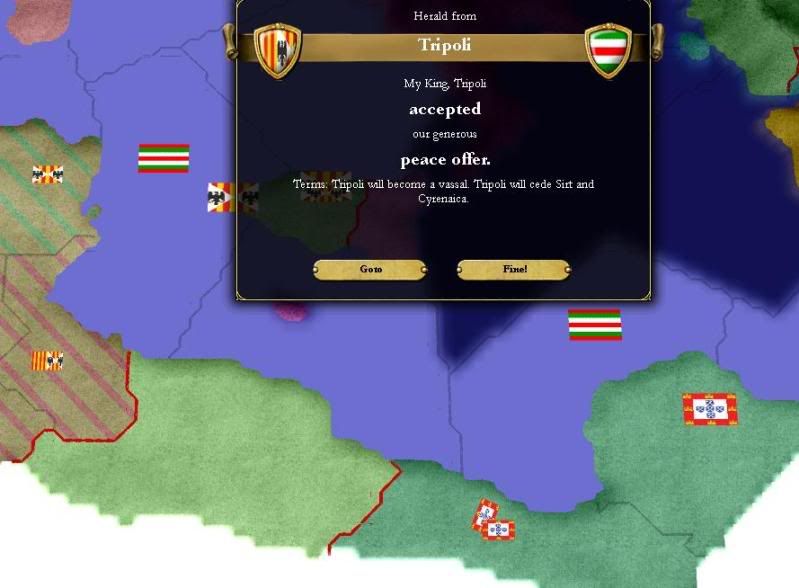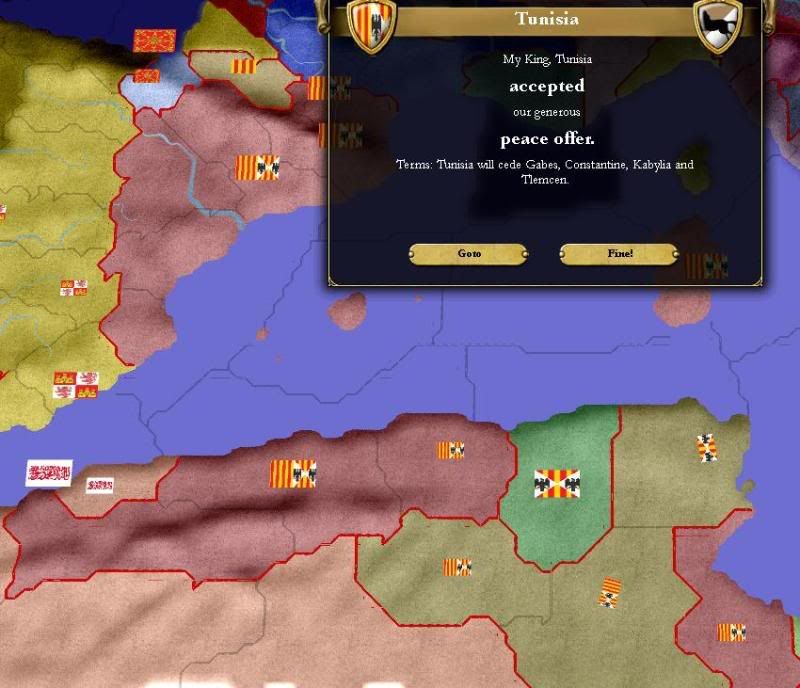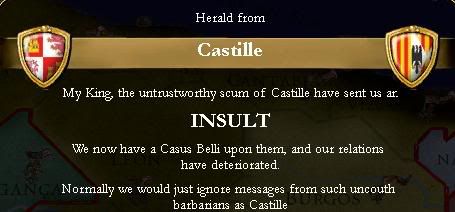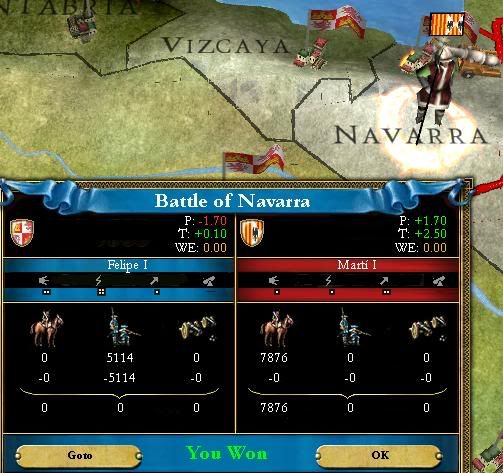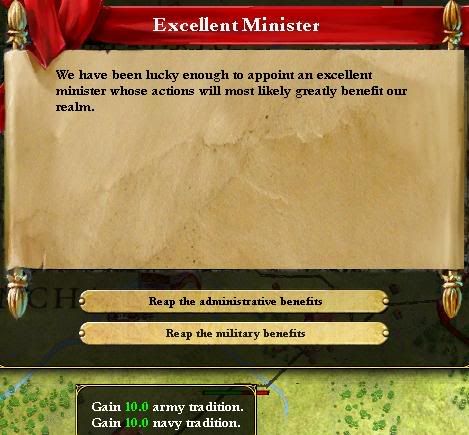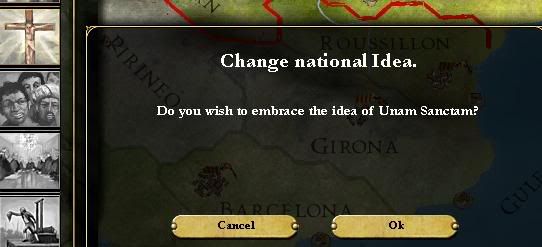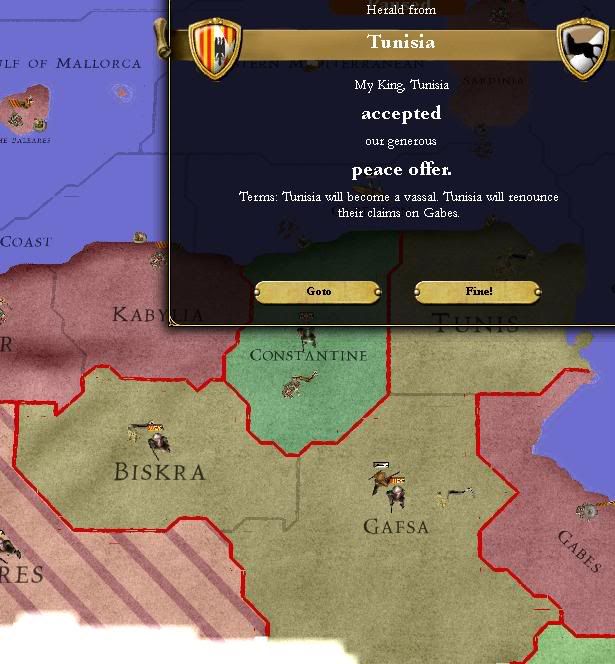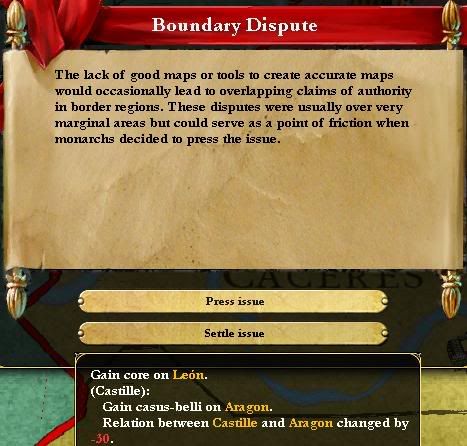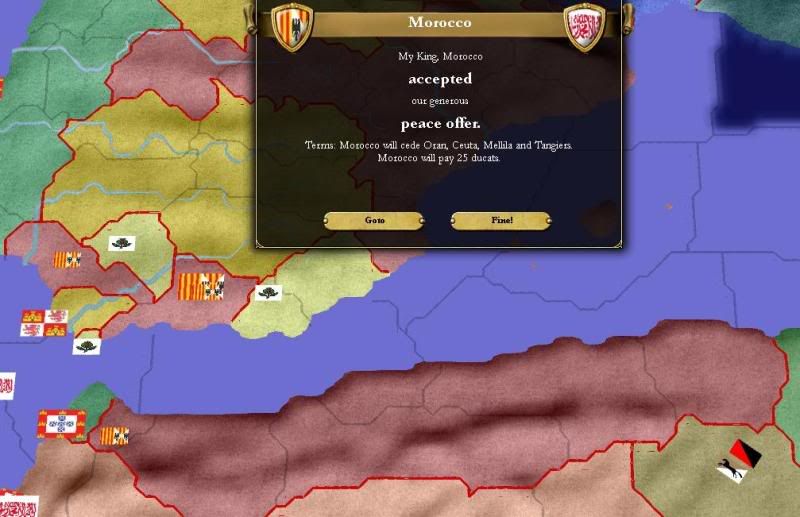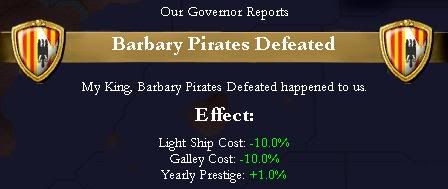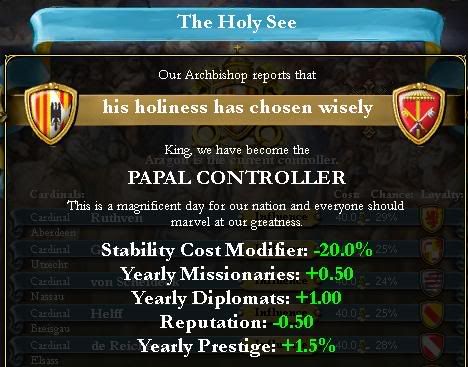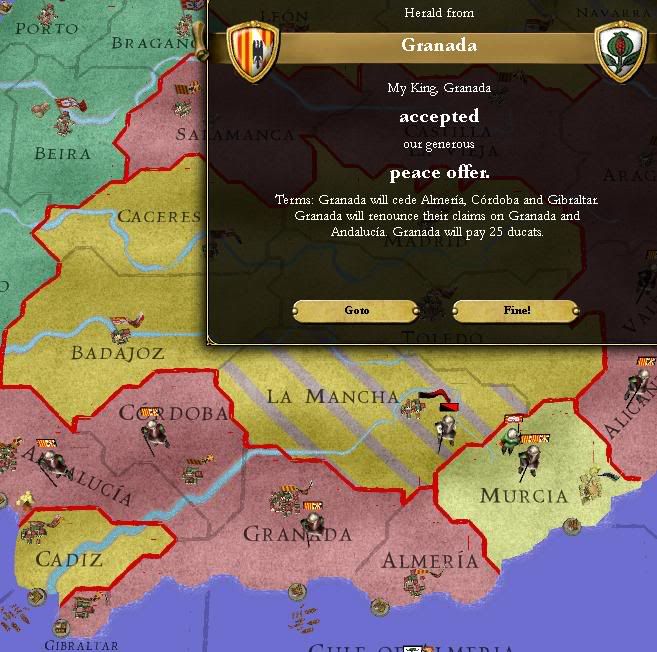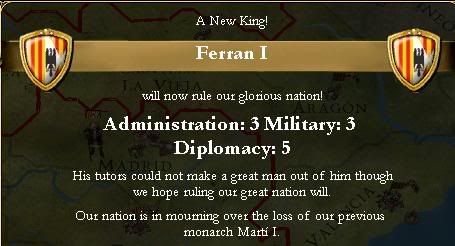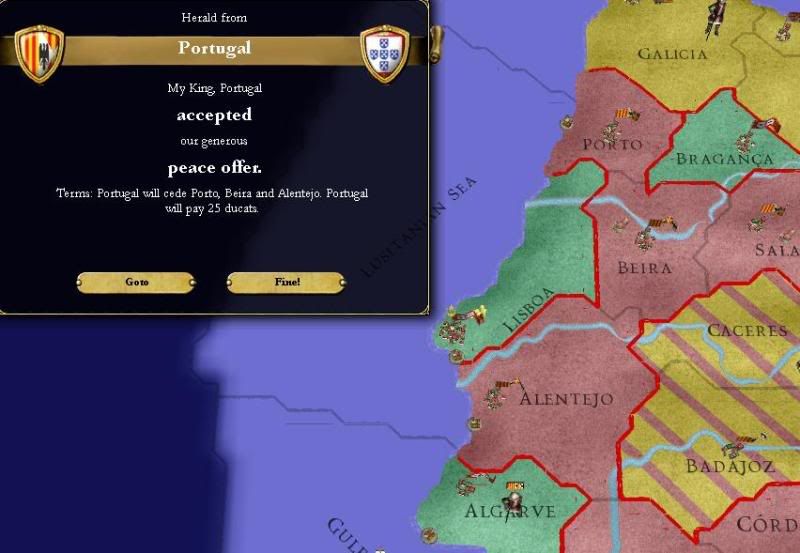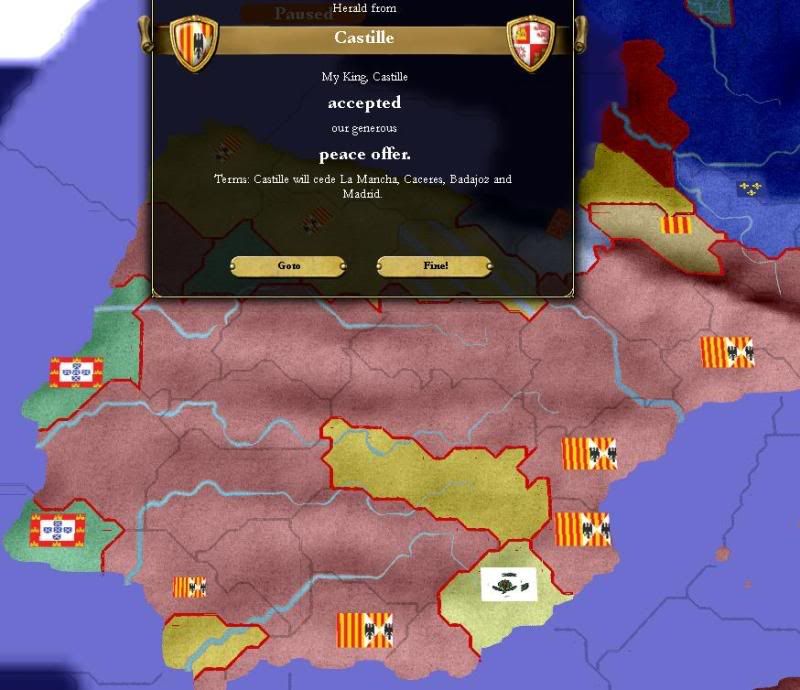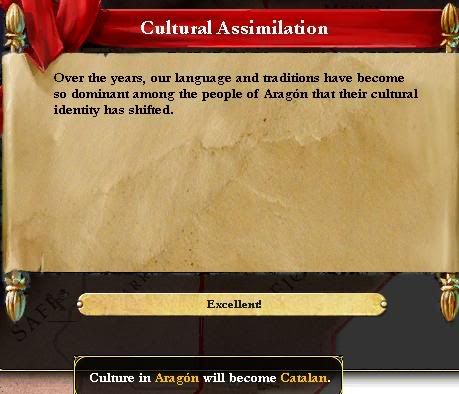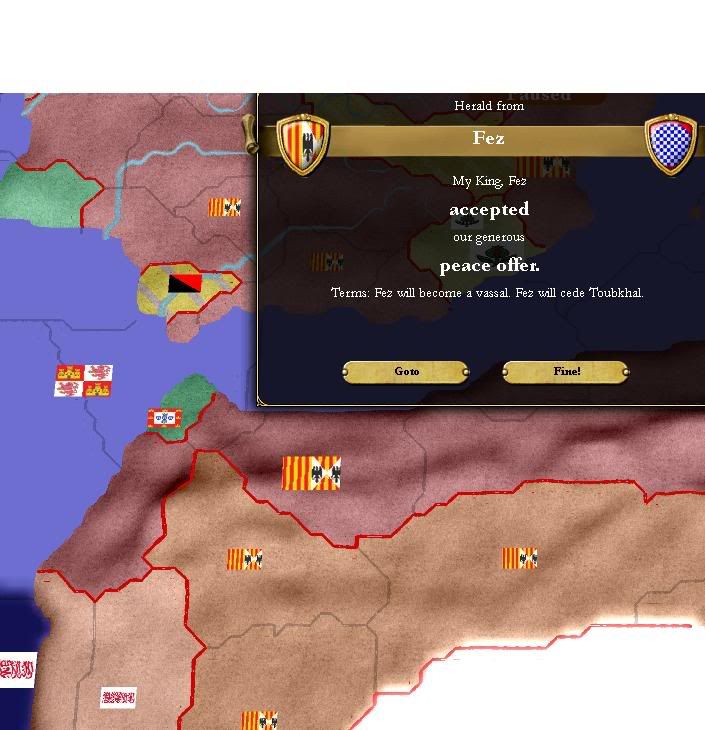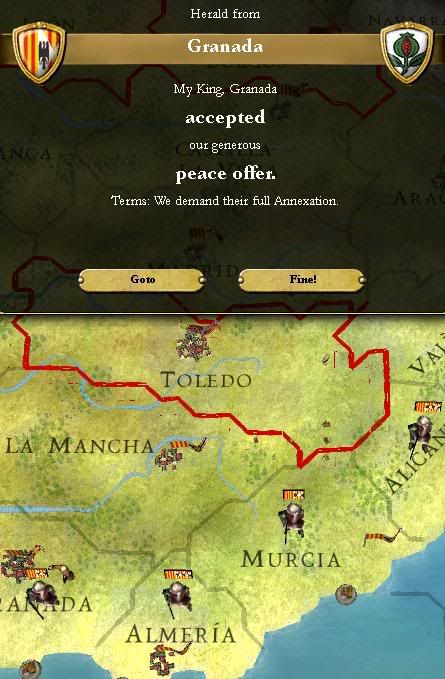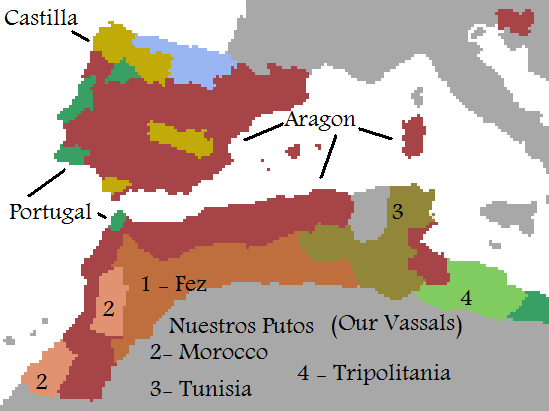Tani Coyote
Son of Huehuecoyotl
- Joined
- May 28, 2007
- Messages
- 15,191
EU3 Aragon AAR
Los Reyes de la Tierra, el Mar y el Mundo
(Title translates as, provided I did everything correctly, "The Kings of the Land, the Sea and the World" )
Modifications:
The Emperor gets a slight bonus to spies by merit of being Emperor. He also gets a little extra spies for the amount of members in the HRE.
War exhaustion decreases faster.
Badboy is a bit easier to get rid of.
Cores now appear after 30 years, coinciding with the demise of a province's nationalism. It takes 60 years to lose a core.
The Curia Controller has been strengthened like in my last AAR, with 1 prestige gained a year alongside the missionary, stability, and diplomat benefits. The prestige and missionaries gained by controlling Cardinals has increased a tad.
Naval tradition decays much slower(1/6 the rate of Land tradition), due to how it is harder to gain.
Settings:
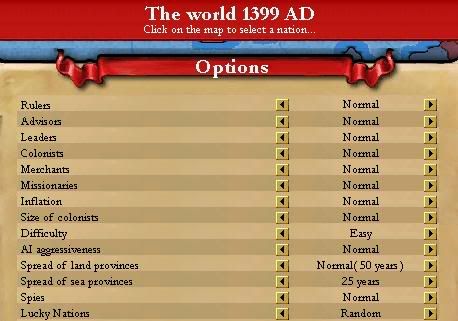
I am playing In Nomine, v 3.2.
Given that this AAR will likely eventually become a Spanish AAR, I will be using my rudimentary knowledge of Español throughout the story for terms. Most of these will be translated on the spot, while I will also use more common ones. Here's a table of common words I will be using:
Enero - January
Febrero - February
Marzo - March
Abril - April
Mayo - May
Junio - June
Julio - July
Agosto - August
Septiembre - September
Octubre - October
Noviembre - November
Diciembre - December
Año - Year
Rey - King
España - Spain
Reina - Queen
Día - Day
Mes - Month
Countries, where possible, will be referred to by their Spanish name...
And, we may begin!
Capítulo I: La Isla de Cerdeña (Chapter I: The Island of Sardinia)
El Año 1399
El día fue Octubre 14, 1399. (The day was October 14, 1399)
As England celebrated the crowning of a new King, the humble Kingdom of Aragon's own Rey was planning what to do with his own kingdom. Living during the Western Schism, el rey de Aragón naturally had a tough time keeping the status quo strong. But thankfully, Aragón was poised for greatness. It already monopolised a large part of Eastern Iberia and colonised the Baleares. To the east, the country of Sicily - and it's territory of Malta - enjoyed friendly relations with el Rey Aragonés(Aragonese King).
But not all was good. In addition to the schism tearing Christianity apart, Iberia was a powder keg ready to explode. Portugal, Castilla(Castile) and the other Iberian states all had designs on the Muslim state of Grenada, the second in particular. Further north, the French King was beginning to centralise, and a powerful France would inherently be a threat to Aragón. To the east, la isla de Cerdeña defied the orders of el Rey Aragonés by refusing to surrender itself to the crown. And even further east, the Balkans and the rich trade routes of the East were under threat as the Byzantine Empire collapsed thanks to the treachery of the Italians and the onslaught of the Turks. What was el rey to do?
Octubre 15, the Rey's advisors decided it was imperative that the Reino - or Kingdom - vassalise Navarre to the northwest, so as to protect it from the rabid forces of Castilla and Francia.
By Octubre 16, two offers of alliances from Lorraine and England were rebuffed; the Rey did not want anything to do with France, saying that Aragon's interest in continental Europe ended where the Pyrenees began. As well, the Rey did not see any benefit to his plans in Iberia and the Western Mediterranean that could be gained from the two countries.
Octubre 27, Portugal and Aragón announced a formal alliance to the world. Once Castilla joined the pack through a series of mutual bilateral agreements, Iberia would be a fortress.
Noviembre, the Rey issued a declaration of war to the Cerdeñanos, who were guaranteed by the state of Aquileia in Italia.
Noviembre 21, both Portugal and Sicily dishonored their alliance with Aragón. As well, Aquileia chose to back up it's guarantee on Cerdeña. But the Rey cared not, for he would be willing to send his forces to invade other countries as well if he had to.
Diciembre 20, the forces of Cerdeña were wiped out, just as Milanese soldiers prepared to offload onto the island.
El Año 1400
Enero, the Reino's navy was positioned outside Cerdeña, patrolling the waters and blocking shipping where possible. It was hoped the Cerdeñanos would grace the Rey with their own naval forces.
Mayo, the alliance with Portugal was reinstated.
Octubre 30, the Cerdeñano forces were defeated again by the combined Milanese-Aragonese forces.
Noviember 4, the stability of the Reino increased to +1.
El Año 1401
Marzo 15, the siege of Cerdeña ended.
Then, the navy of the enemy was crushed. The island had no hope left for survival.
Desiring to expand his Reino there and then, the Rey annexed Cerdeña in Mayo:
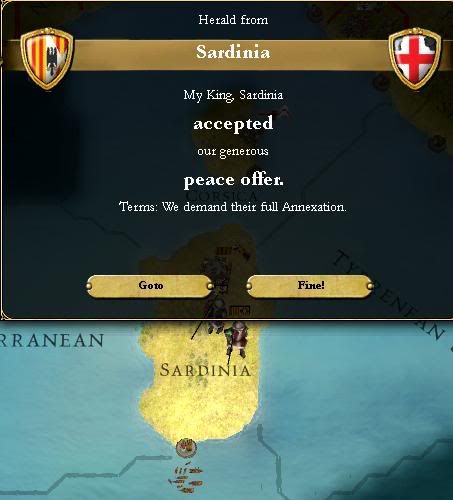
Now that the island nation had been reabsorbed into it's rightful Aragonese owner, the Rey decided it was time to bring the fight to the state of Aquileia. Possessing two gold-rich provinces, the Rey knew capturing and conquering them would bring countless riches to Aragón.
First, the Rey compared the forces of the two Reinos. Aragón had 2,000 cavalrymen and 3,000 Halberd infantry, whereas Aquileia's army was composed of 3,000 cavalrymen and 3,000 Halberd infantry. Accordingly, the Rey ordered more troops to be trained before any major campaign would take place. To facilitate a stealthier approach, the Rey tried to acquire military access through the Italian peninsula, so that troops could move overland and catch the Aquileians off guard.
Mayo 13, the Venetians accepted to let Aragonese forces use their ports and lands.
Mayo 15, the Milanese agreed to the same terms... 3 cavalry regiments and 1 Halberd infantry regiment were commissioned in the home territories. Rey Martí was convinced by some of the elite to personally lead the assault on Aquileia, and so he took to the field as a semi-capable general.
By late Septiembre, 4,000 soldiers had arrived in Italia. They began an eastward march towards Aquileia, as vessels went to transport the other 5,000 soldiers of the Aragonese army.
Out of fear, Aquileia sent an emissary in Octubre. However, they made a fatal slipup and demanded that the Rey pay a large bounty in exchange for peace. The emissary's life was spared due to etiquette, but in vengeance for such a terrible offer, the "representative" of the ruler of Aquileia was dipped in the largest vat of vaca(cow) dung available.
Noviembre, the first half of the Aragonese army reached the Venetian border with Aquileia. Right across, Archbishop Antonio II's soldiers were positioned for combat. Numbering 7,000 strong, Aragón would only strike after it's own forces managed to number 9,000, under the Rey.
Diciembre 17, the full force of the two armies were on opposite sides of the border; Aragón with 9,000 soldiers - 5,000 cavalry - and Aquileia with 8,000 - 3,000 cavalry. Before riding into combat, the Rey issued a number of edicts in case he died in combat. Most notably, he mandated that the government take a less protectionist stance in the economy, and focus on fostering competition to fuel innovation and more wealth instead.

This upset the merchants greatly, and many chose to leave their fields. But the Rey's response in a letter was: "En el futuro, they will call this a 'market correction cycle.'" In other words, he didn't give a lumpy, peanut decorated piece of excrement that they left, as this meant the more innovative and adaptative merchants would take up the reins of commerce.
El Año 1402
Febrero, the stability of the Reino increased to +2 as the battle against the Aquileian Army raged.
The battle ended in Marzo, but it was too indecisive:
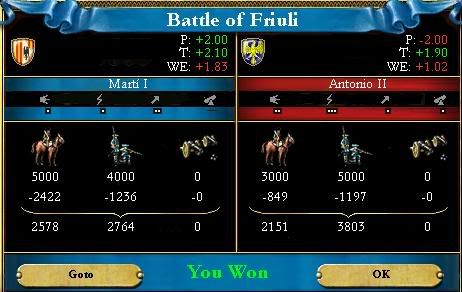
Abril 1, a better victory was won at Gorz, but only by a narrow margin. The Rey developed a strategy to keep pursuing the demoralised Aquileians until they were finished. At the same time, more forces would be transported from the homeland to fight in the war.
Junio 27, while Aragón had won many victories against the Aquileians, they were all indecisive and often cost far more than they gained. As a result, the Rey ordered his forces to retreat to Venetian territory until more troops could arrive. A massive force could then storm Aquileia and overwhelm them.
As the year went by, the Rey's troops recovered.
El Año 1403
En Enero, the Rey led a force of 12,000 soldiers into Aquileia. He outnumbered the 9,000 strong Aquileians, and he also wielded far more cavalry.
Febrero, the battle of Friuli resulted in a mild victory for Aragón. The Rey ordered his soldiers to pursue Archbishop Antonio II. There was a great victory at Gorz shortly after, and it was hoped the trend of Pyhrric victories had finally ended.
By late Marzo, another battle had begun in Gorz. The Aquileian Army was now in a sorry state, having less than 1,000 cavalry.
Abril, the stability of Aragón finally increased to +3.
By late Mayo, the Rey finally received the victory he had long awaited:
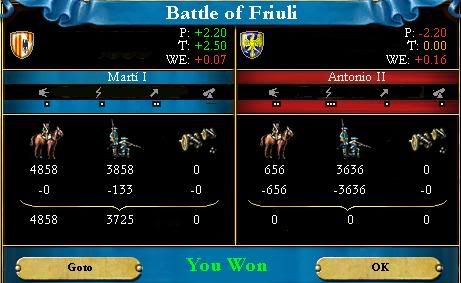
With the enemy army wiped off the face of the planet, Rey Martí had free reign over all of Aquileia. He ordered his troops to move quickly to cover every square inch of enemy territory.
Mayo 29, the Rey arrived in Gorz, only to find out that 2,000 more troops had been raised by the enemy... he immediately rode off to fight them while they were weak.
By mid-Julio, two enemy armies were destroyed. However, the Archbishop continued to raise mercenaries; only God knew how.
By early Agosto, the last units of the enemy were annihilated. But how long would it last?
In the last meses of the year, the army spent it's efforts covering Aquileia. The army personally led by the Rey naturally did the most damage.
El Año 1404
Enero, as the annual taxes flooded the treasury with more of a war cushion, the sieges in Aquileia continued.
Febrero, the province of Krain fell:
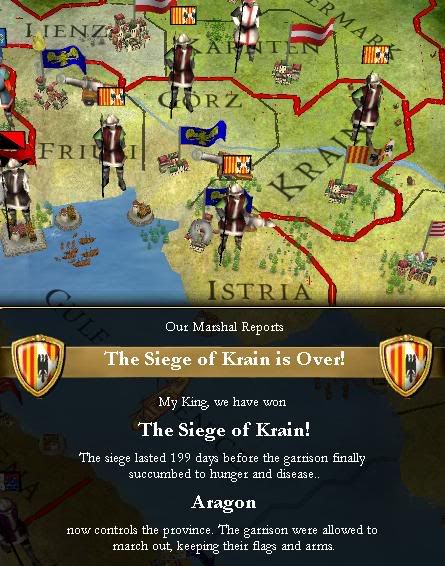
Mayo, the Rey arranged for a member of his family to be married to the ruler of Naples, thus merging Aragón's royal house with the Milanese, Austrians, Neopolitans, and Sicilians in and around Italia.
Junio de 1404, the province of Friuli fell to the victorious Aragonese military.
Septiembre 9, to increase the influence of Aragón in the Curia, the Cardinal de La Mancha was "influenced" to the Rey's side.
Mere days later, as if by divine favor, the province of Gorz fell to the Aragonese military. Only the province of Istria remained outside the hands of the Iberian invaders.
El Año 1405
Early Marzo, the Rey decided it was time to end the long, drawn-out battle. He led an assault against the last fortresses of Istria, and by Marzo 10, the last province of Aquileia had collapsed...
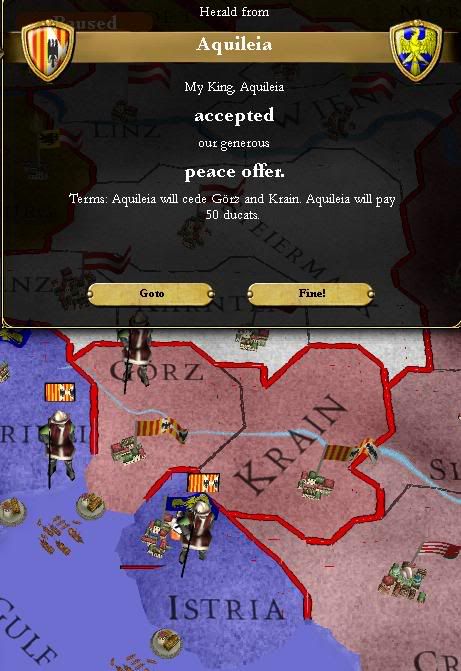
A few days after the fall of Istria, Aquileia accepted the humiliating peace terms imposed by Aragón.
By mid-Abril, ships were bound for the East to retrieve most of the forces deposited in the gold-rich territories acquired during the war. But where would Aragón go next...?
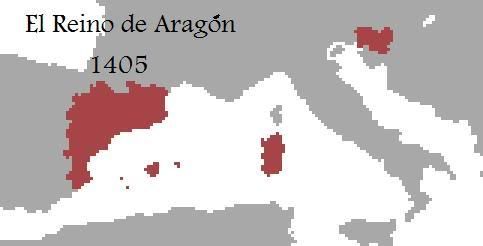

 In this game, Venice seems to be led by a shadow of Marius left over from my EU2 AAR. Showing ambition, the Venetians have already annexed Urbino. As I feel that's a somewhat-realistic conquest(as it would reinforce Venice's power in the Adriatic), I am going to give them a core on it now. Should make for turning Italy into a more neat game... besides, Milan is freaking huge, and Venice needs to be able to counter.
In this game, Venice seems to be led by a shadow of Marius left over from my EU2 AAR. Showing ambition, the Venetians have already annexed Urbino. As I feel that's a somewhat-realistic conquest(as it would reinforce Venice's power in the Adriatic), I am going to give them a core on it now. Should make for turning Italy into a more neat game... besides, Milan is freaking huge, and Venice needs to be able to counter.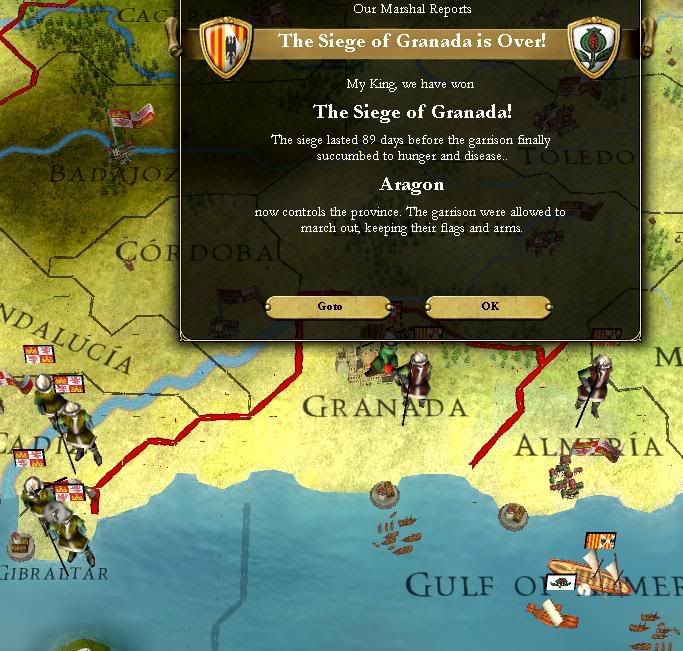
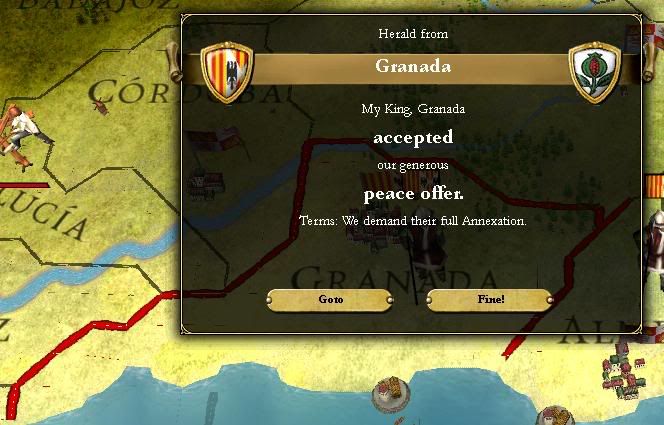
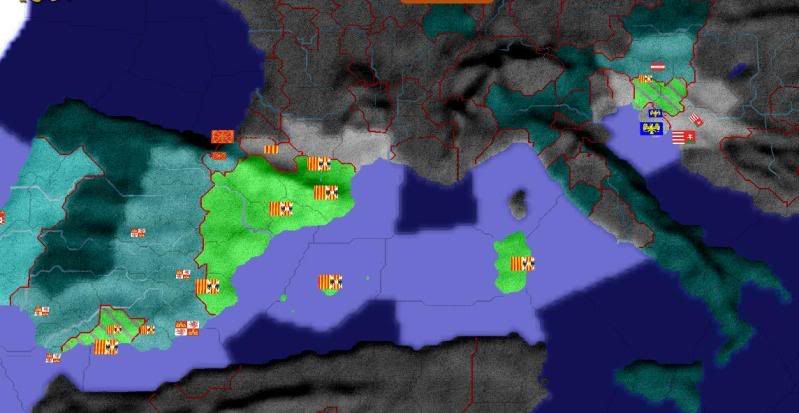

 I could type it all in Spanish! ...Though I'd have to provide an English translation for the whole thing due to the forum rules, however, and I'm too lazy to do both.
I could type it all in Spanish! ...Though I'd have to provide an English translation for the whole thing due to the forum rules, however, and I'm too lazy to do both. 


